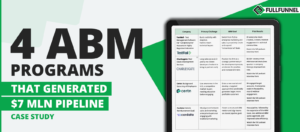In this guide, I’ll walk you through the exact process we use to develop and execute a high-impact Account-Based Content Strategy.
This is the same step-by-step framework we apply ourselves, and in our consulting projects, including:
- A pilot ABM program that enabled CrossKnowlegde to increase marketing contribution to qualified pipeline from 35% to 60% and engage 26% of their target accounts in multiple meetings and project discussions (35 out of 130 target accounts during a six month period)
- An account-based content strategy that helped Charlesgate achieve a record sales quarter (generating $3m+ revenue for the lead sales rep who joined the ABM pilot), in a market with 2+ years sales cycles
- Helped FullFunnel.io generate a 7-figure pipeline, and claim a position as a go-to brand when it comes to ABM and full-funnel marketing
After reading this article, you will walk away with:
- Create awareness in target accounts’ buying centers.
- Showcase our solutions to their specific challenges.
- Create engagement opportunities for sales.
- Help sales get insider information on target account priorities and challenges.
- Demonstrate the cost of inaction and the ROI.
- Showcase specific solutions and outcomes to an account’s high-priority challenges.
- Answer our buyers’ critical questions.
- Help accelerate time-to-value of new product implementations.
- Showcase how we can support evolving use cases and priorities.
Featured downloads (click on the link below to download):
Seven content-led ABM playbooks, examples of content for every stage of the buyer journey and a collection of account-based content strategy case studies.
Table of Contents
ToggleThe Role of Content in ABM vs. Traditional Content Marketing (with 12 content examples)
Traditional B2B content approach is frequently focused on generating traffic (via SEO) and marketing-qualified leads (MQLs) via white papers or other types of gated content.
In ABM, content strategy needs to adapt to the goals of your ABM programs. We usually break down ABM programs into four groups:
- Net-new pipeline and revenue: generate more opportunities, that are larger, and win more of them.
- Pipeline acceleration, which is about winning more pipeline deals, faster.
- Expansions and up-sells, because when selling to enterprise accounts, the biggest opportunity is not in landing new accounts, but expanding the existing ones.
- Renewals, which for most B2B SaaS companies generate the vast majority of their revenue, but are frequently not proactively addressed.
Here is how the role of content changes with the different ABM goals.
1️⃣ Role of content in net-new pipeline and revenue programs
1. Create awareness in target accounts’ buying centers. If there’s one challenge we repeatedly hear from salespeople, it’s the lack of awareness and recognition of our brand. Buyers these days receive so much outbound they ignore messages from people they don’t know.
Awareness creation is especially important when selling to enterprise accounts, because 83% of enterprise buyers will short list a vendor they discovered BEFORE they started a buying process.
In the below example, a CFO was engaging with my posts, and I used that to start a conversation that ended up in a call (and later, in a won deal). I ended up talking to five different buyers. They all knew me, although they were not engaging with my posts. How? The CFO was sharing my posts in the private team Slack channel.

2. Demonstrate how the solution addresses specific strategic challenges of our target accounts.
Example: A head of marketing of a 50k+ employee tech brand, reaches after attending live podcast episodes and reading our newsletter about their “high pain points”:

3. Nurture your buyers and “sow the seeds”.. Most of the buyers are not in the buying mode, and are dealing with their challenges the best way they can. Your content should challenge the status quo and show gaps in current processes and implementation.
Example: Buyer reaches out after reading a highly relevant piece of content that challenges their current approach:
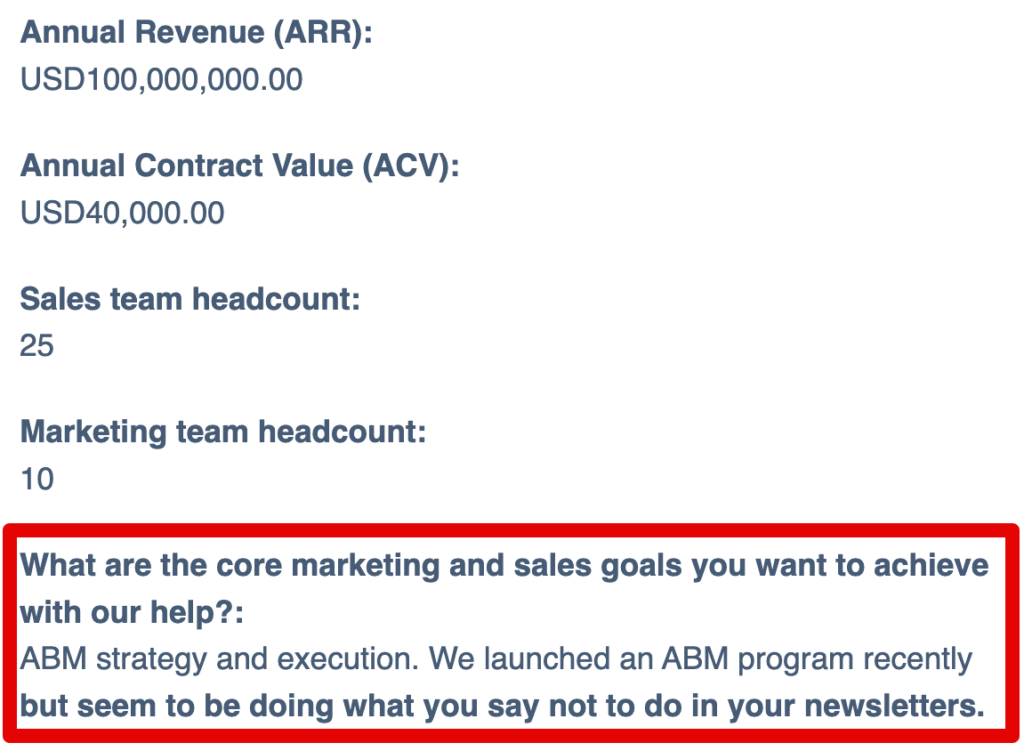
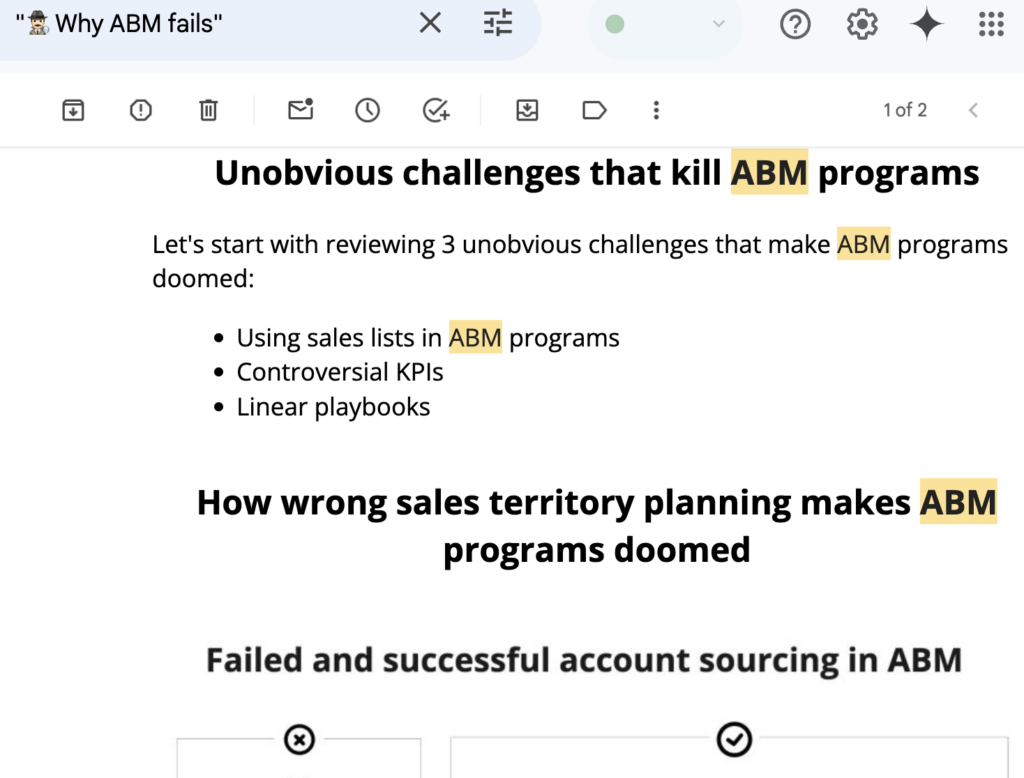
4. Equip sales teams with content to open doors and initiate meaningful conversations.
Below is an example of engagement-based outreach: connecting or messaging people based on their engagement with your content. With this approach, sales can easily achieve 30%+ response rates to their outreach.

5. Help sales get insider information into target account priorities and challenges.
In the below example, Andrei is reaching out to registrants for an event we ran on a partner event, and asking what is the number one challenge they are looking to learn more about during our keynote.
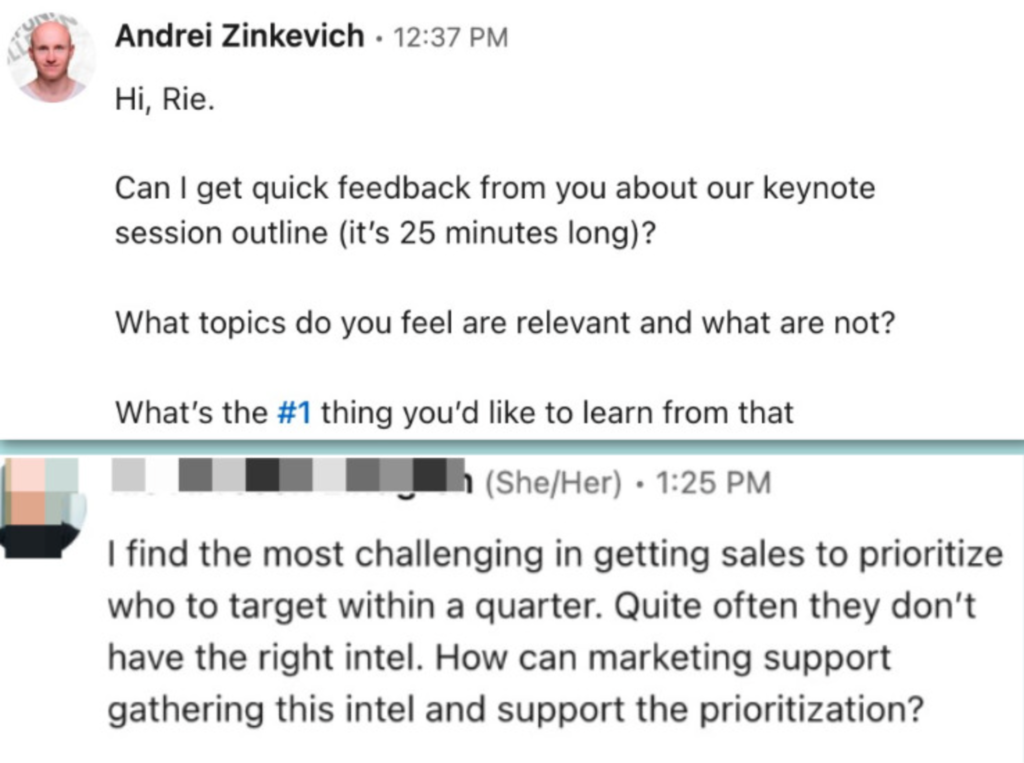
2️⃣ Role of buyer enablement content in pipeline acceleration programs
Since we have implemented the below pipeline acceleration programs and content, our win rates have increased from 12.5% to 50%. This is where buyer enablement content becomes crucial.
1. Content should help champions sell internally by explaining the cost of inaction and the ROI of the proposed solution.
In the example below, I’m helping the prospect champion build a business case to present the new ABM program to their leadership team.


2. Answer critical questions and proactively address objections of different buyers within the buying committee.
In the below example, I’m using content to answer the most critical questions from one of our buyers.
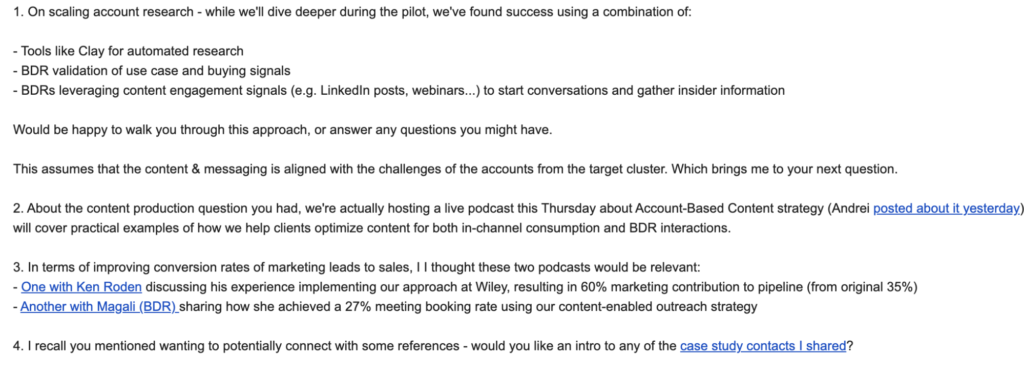
3. Showcase specific (1:1 personalized) solutions and outcomes to the account’s high priority challenges.
We each prospect in our pipeline, we create 1:1 personalized content hubs, outlining solutions to their stated challenges, and answering the most critical questions they have.
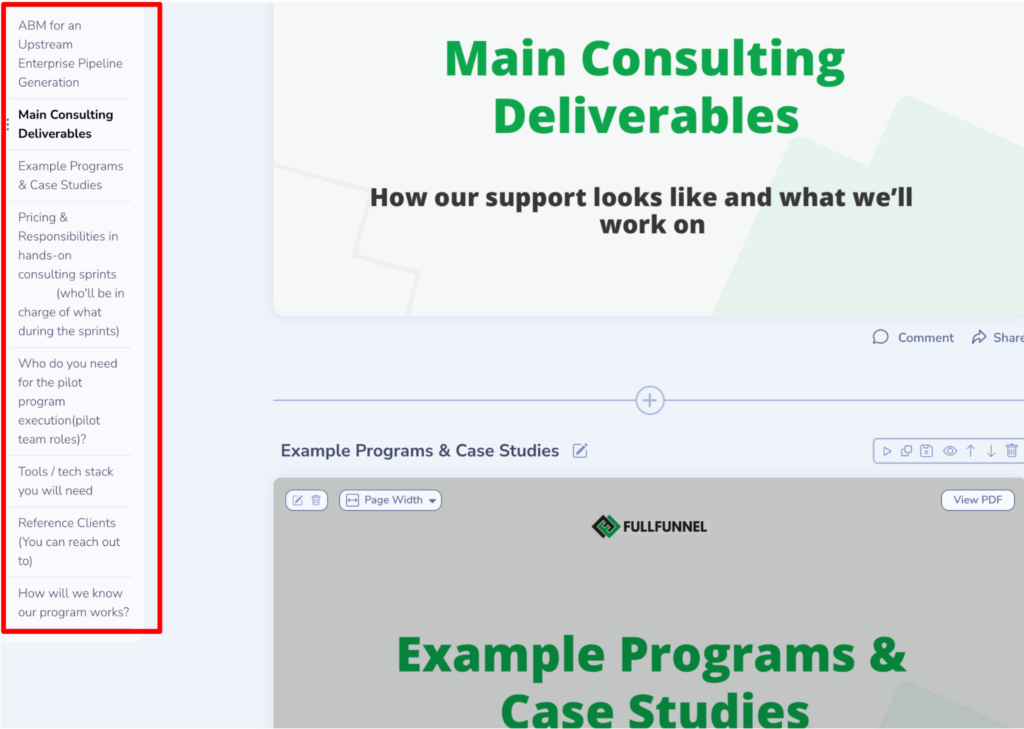
4. Provide case studies and personalized insights to guide decision-making.
We always include relevant, detailed case studies of similar companies struggling with similar challenges (accounts from the same account cluster, more on that below). The best case studies are live podcast interviews, as they drastically increase credibility and are unfiltered, behind-the-scenes stories of exactly what we did with our clients’ teams and what the results were. We always collect and answer our audience questions.
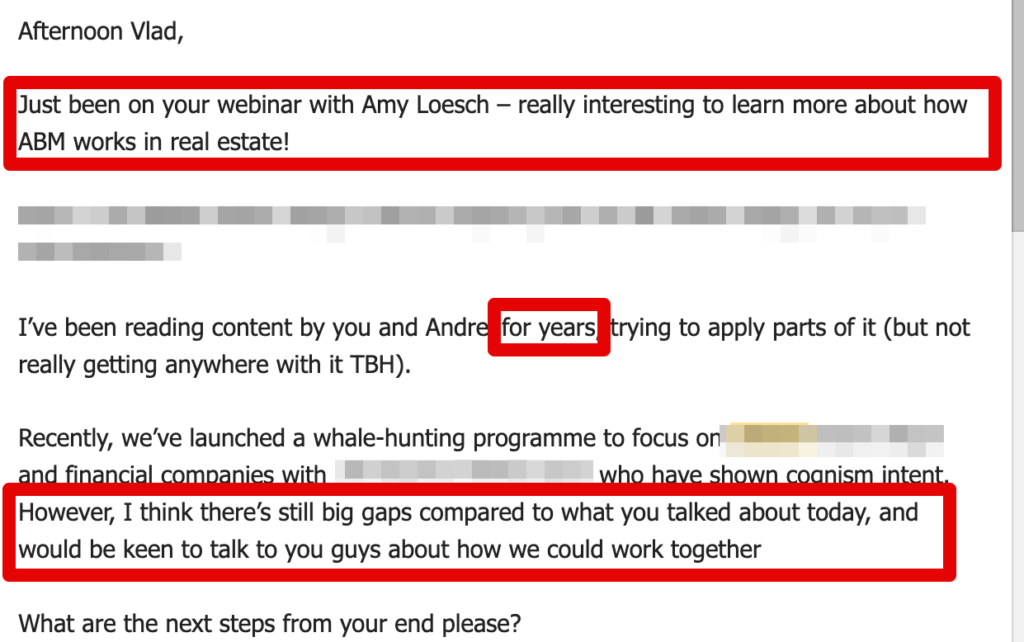
3️⃣ Role of content in expansion and renewal programs
Once a deal is closed, content should support:
1. Time to value – helping customers achieve success with the product quickly.
We provide our client teams with detailed, personalized playbooks to enable their teams to execute the ABM pilots we set up together.

2. Customer advocacy – capturing the success of the implementation as customer stories and detailed case studies, and featuring internal champions – and power users in content to help influence adoption and potential expansion within the organization.
In the example below, we’ve developed an internal presentation for the broader sales team, featuring the results their pilot team obtained during the initial phase, to get their buy-in and implement a wider program.
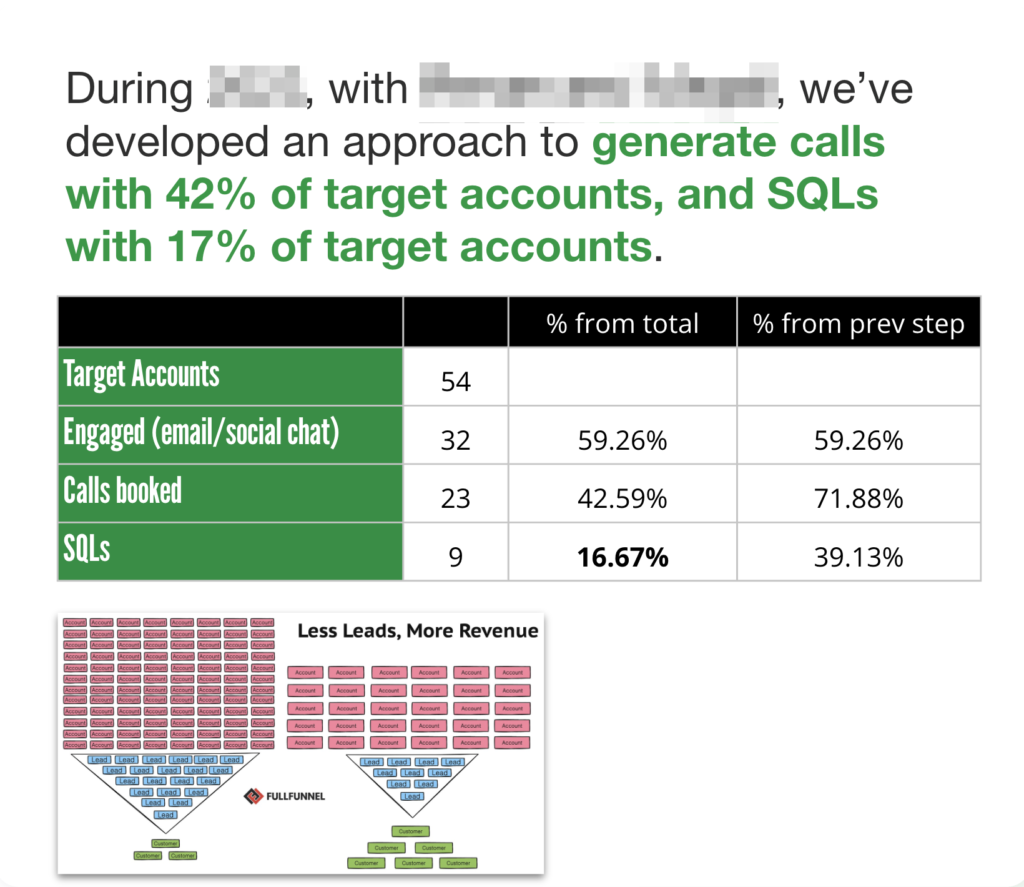
3. Evolving priorities – educating customers on additional use cases, product features and specific solutions as their needs grow and their priorities change.
In the below example, we’ve been educating our customers about how to expand their initial successful regional program to other regions.
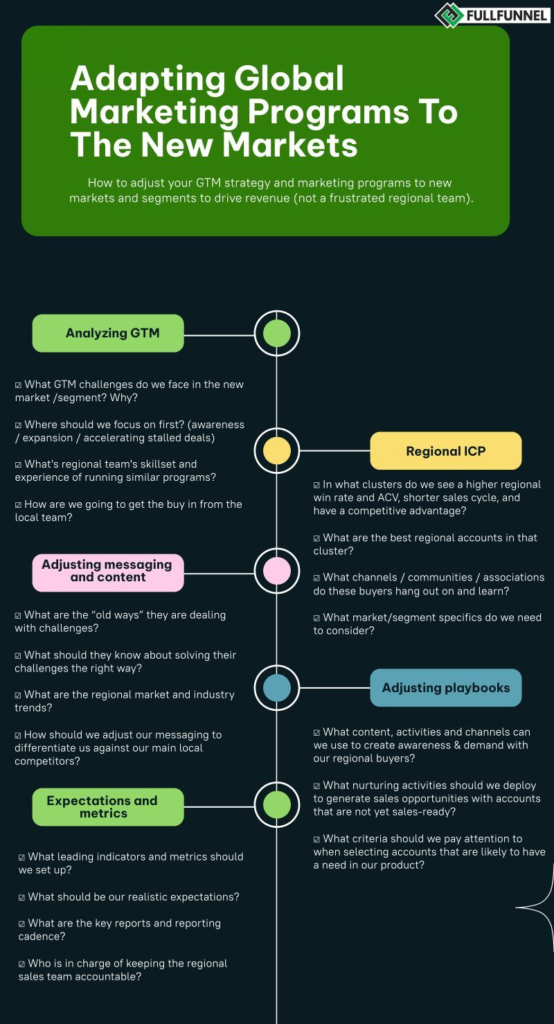
The account-based content team
Content is one of the most undervalued areas of an ABM strategy. If you don’t resource and structure your ABM team properly, your ABM program is likely to underperform—or completely fail.
Most companies struggle with content in ABM due to the following reasons.
1. Lack of Dedicated Content Resources for ABM
Many B2B companies lack dedicated content resources on their ABM team, or rely on junior marketers, or external freelancers and agencies with no domain knowledge.
Symptoms of this problem:
- Content isn’t personalized enough for the target accounts.
- Marketing repackages existing ineffective content instead of creating account-specific materials linked to their challenges.
- Sales teams don’t want to share content as they don’t think it’s relevant and that it can help them engage target accounts
- There is no clear owner for ABM content creation.
2. Siloed content teams and corporate content inertia
Larger organizations often have to rely on siloed content teams that operate as a separate function, focused on:
- Brand voice & messaging consistency (instead of driving revenue).
- Content calendars & blog production (instead of aligning with sales needs and priority accounts in the pipeline).
- Press releases & corporate comms (instead of sales enablement).
These teams have their own agenda and KPIs, which are not aligned with ABM programs, target account challenges, and the needs of the sales team. Frequently, it’s hard to influence their agenda, priorities and their approach.
When content teams are siloed, they don’t care about ABM success. They follow their own editorial calendar, focusing on corporate messaging rather than producing content that helps convert key accounts. This is “corporate content inertia” at play.
As a result, teams frequently suffer with bottlenecks, delays and content that’s ineffective and doesn’t influence the buyers in target accounts.
How to Fix These Problems
✅ Hire or allocate a dedicated ABM content marketer. This role should sit within the ABM team, not a general marketing function.
✅ Create an integrated ABM team that includes:
- ABM Lead
- Content Marketer
- Subject Matter Expert (SME)
- Sales Representatives
✅ Shift from broad content production to targeted content creation. The goal is not volume—it’s about creating high-impact, relevant content that moves accounts forward.
✅ Define the ABM content marketer’s key responsibilities:
- Working directly with sales to understand the needs of target accounts.
- Personalizing content at different levels (one-to-one, one-to-few, one-to-many).
- Collaborating with subject matter experts to create insightful, high-value content.
✅ Use subject matter experts who understand the target audience’s challenges, internal processes, and pain points.
✅ Ensure content is co-created with input from marketing and sales to reflect real buyer challenges.
Check out the live case study we did with a client, sharing the structure and details of an account-based content strategy of one of our clients.
Aligning Content with Account Clusters
In traditional B2B marketing, companies rely on buyer personas to define their target audience. At best, teams try to align their content strategy with target industry verticals and roles.
Buyer personas lack strategic depth. They describe a generic individual but fail to account for organizational priorities, industry dynamics, and specific use cases. Even when you define an ICP (Ideal Customer Profile) for an industry vertical, it doesn’t tell you how to align content with the different use cases your customers might have. You need to dig deeper.
A traditional ICP might define an ideal target as:
✅ SaaS companies
✅ $50M+ revenue
✅ 500+ employees
✅ Using Salesforce
But this doesn’t tell you why they need your solution. This is where account clusters become essential.
Instead, clustering focuses on the strategic use case and pain points driving their buying decisions.
Here are example clusters for a CRM vendor (e.g. Hubspot). Note the sales velocity criteria used to prioritize clusters for the ABM program.
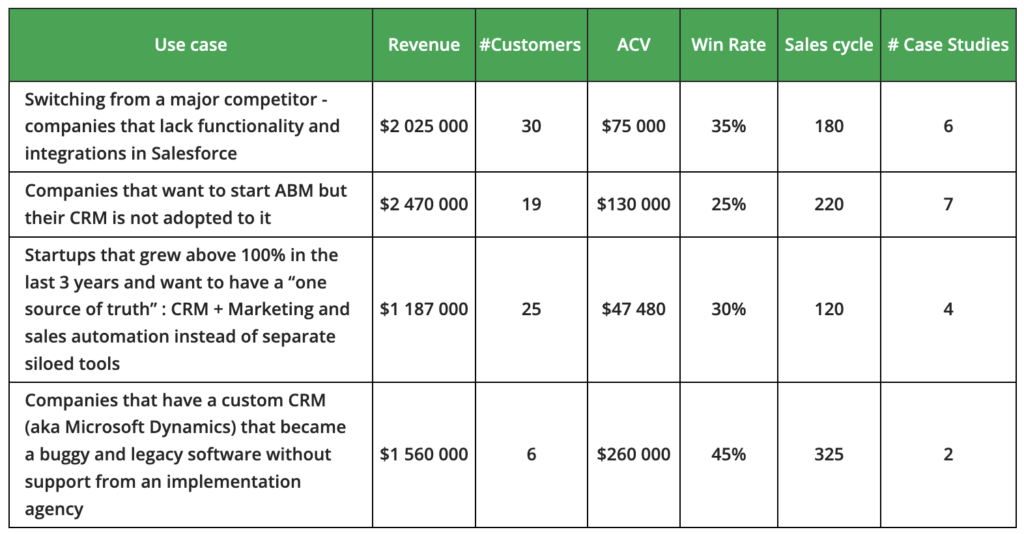
By clustering accounts based on why they buy rather than who they are, the ABM team can align content, messaging, and outreach and engagement playbooks more effectively.
Aligning Account-Based Content with the Buyer Journey
The key to ABM success isn’t creating more content—it’s creating the right content for the right stage of the buyer journey. Every piece must serve a purpose: educate, influence, or accelerate deals.
This requires mapping content to the buyer journey based on:
✅ The level of demand and intent (No/Low Intent, Medium Intent, High Intent)
✅ The buying committee’s concerns (What do different stakeholders need?)
✅ The actions we want buyers to take (How do we move them forward?)
Here is a simple model with three buyer journey stages and account-based content, with more details about the each stage below.
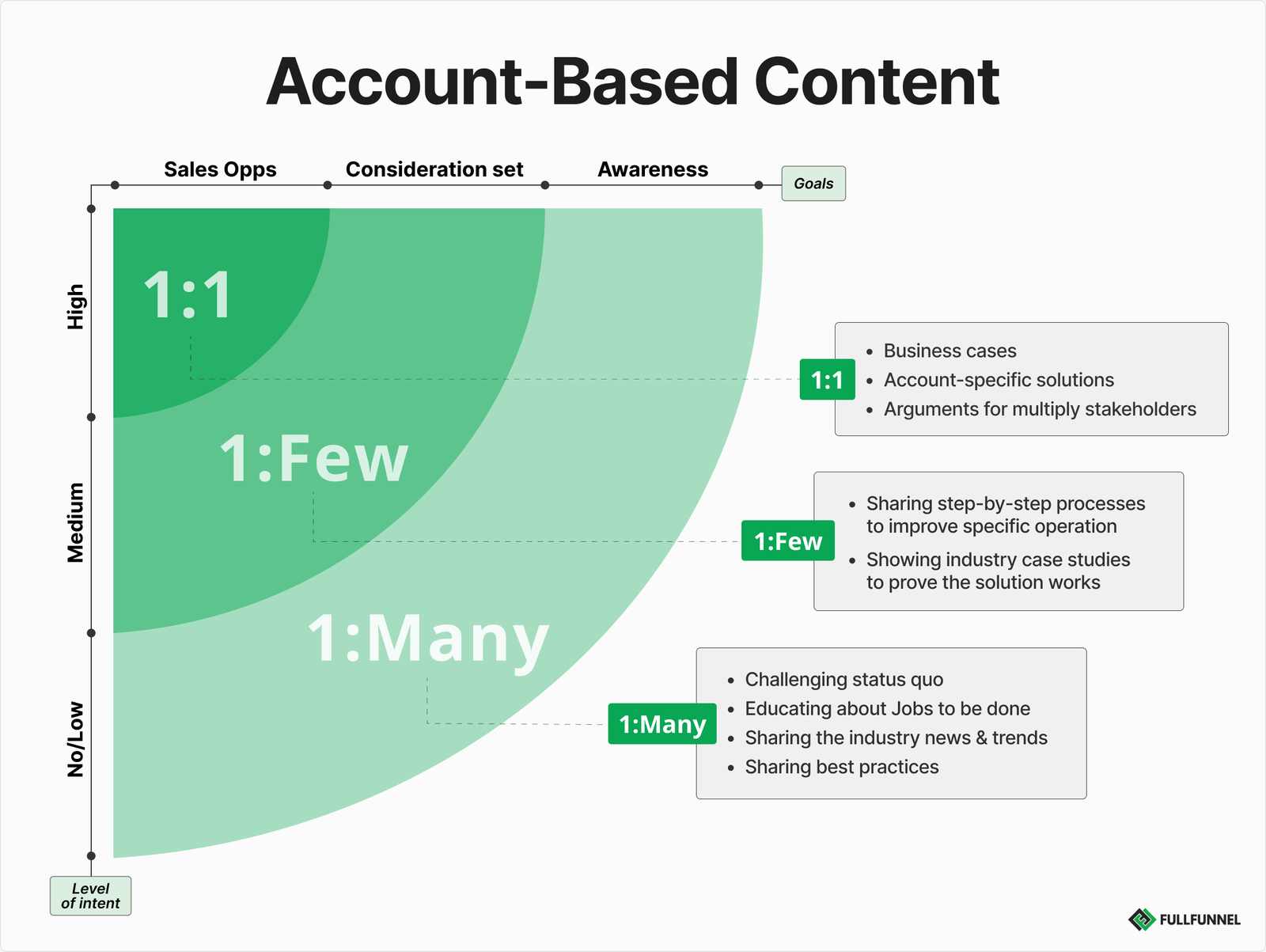
1️⃣ No or Low Intent: Creating Awareness & Challenging the Status Quo
Most of your buyers aren’t in-market today. Your job is to make sure that when they are, they think of you first
📌 Who They Are:
- Buyers aren’t actively looking for a solution.
- They may not even realize they have a problem.
- They are passively learning—reading industry content, attending events, and networking with peers.
📌 Goals for content at this stage:
✅ Attract their attention, and associate our brand with their strategic challenges.
✅ Challenge the status quo and seed future demand.
✅ Position your company and your salespeople as trusted advisors.
📌 Example account-based content formats we use:
- Daily LinkedIn thought leadership about ABM, Full-Funnel Marketing, B2B demand generation.
- Weekly email newsletter
- Weekly live podcast
- Quarterly step-by-step webinars
- Annual Full-Funnel Summit
The key here is consistency. Instead of a content calendar, we use a simple calendar of daily, weekly, quarterly and annual activities.

2️⃣ Medium Intent: Demand Generation & Solution Positioning
📌 Who They Are:
- Buyers acknowledge a challenge but are still exploring solutions.
- They may be researching different approaches—not necessarily looking at vendors yet.
- Internal discussions about the problem are happening, but no decision has been made.
📌 Goal of Content at This Stage:
✅ Help buyers connect the dots between their challenges and your solution.
✅ Showcase different solutions and position yours as the best.
✅ Move them from research to active engagement.
📌 Best Account-bAsed Content Formats:
- Cluster + Jobs-To-Be-Done Specific content, e.g. How to successfully replicate your pilot ABM program with the regional teams?
- Playbooks & templates, for example, “ABM Implementation Checklist for B2B SaaS”
- Detailed industry case studies with our clients: video interviews + content summary, where we review specific ABM programs in detail.
- Deep-dive webinars & workshops, e.g. “Three Playbooks to Scale Revenue with Account-Based Marketing”
3️⃣ High Intent: Demand Capture, Creating Deals & Buyer Enablement
📌 Who they are:
- Buyers are starting to actively engage in conversations with vendors.
- They have internal discussions about solutions and are looking for proof points.
- The deal champions need help selling the solution internally to the buying committee.
📌 Goals of content at this stage:
✅ Address specific objections and concerns
✅ Equip champions with the right materials to justify the purchase
✅ Create urgency and reduce perceived risk
📌 Example Content Formats:
- Fully personalized business cases and solutions for a specific account
- Implementation plans and process maps
- Stakeholder-specific content: e.g. how sales will benefit from ABM, financial ROI / business case for executives, security audit for IT teams
Tune in to the following case study where we highlight how account-specific content can be used by the sales reps:
🌍 Cluster-based content framework and creating content journeys
We use the following framework to develop cluster-based programs, and the supporting content strategy. The key concept is breaking down accounts into three lists, depending on their buyer journey, and to align the content and activities accordingly:
- CLUSTER ICP: Accounts that belong to the target cluster, filtered by qualification criteria and their fit to the target cluster use-case, but have no vendor awareness. The goal of the content here is to attract the attention of target buyers and create awareness, by associating our brand and solutions to the buyers’ top-of-mind strategic challenges
- FUTURE PIPELINE: engaged Tier 1 and Tier 2 accounts with a vendor awareness, but little evidence of a product need and a limited relationship with the target buyers. The goal is to introduce multiple meaningful touchpoints, “sow the seeds” for changing the status quo, and enable the sales team to collect insider information and validate the product need.
- ACTIVE FOCUS: accounts with high likelihood of becoming an opportunity this quarter. The goal here is to create personalized solutions and create sales-qualified deals.
One important aspect of ABM programs is to avoid siloed stages, content and activities, but rather think of them as connected account journeys.
Account Journey Example: How to Move Target Accounts from Awareness to Sales Conversations
One of the most effective ways to structure an ABM content journey is by organizing it around account clusters—groups of companies that share similar characteristics, pain points, and business needs.
This example outlines a cluster-based program designed for tech companies introducing ABM for the first time, showing how content and activities were mapped to different buying stages to progress target accounts toward sales conversations.
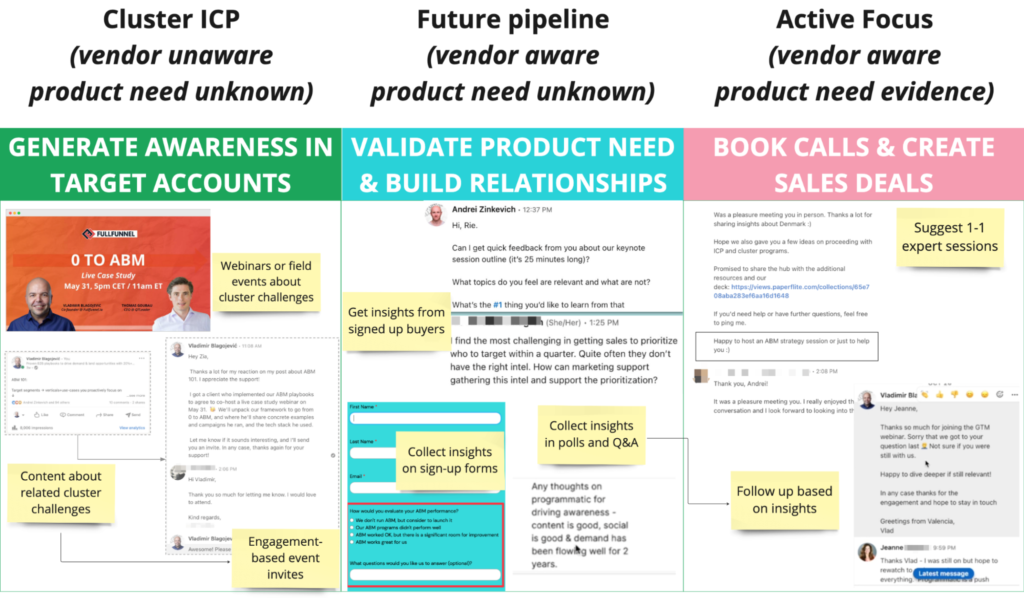
To learn more about account journeys and how to properly involve account executives, listen to the podcast we created with an enterprise sales rep of one of our clients, where she shares how she is using content in their ABM program to create account-based journeys, engage their buyers and create sales deals.
✅ Content quality checklist
The majority of B2B content is superficial, me-too content that doesn’t make an impact on the target buyers. Try using the following checklist to evaluate if your content is relevant, engaging, valuable, and structured for impact.
Content Relevance
✅ Is the topic sourced from customer research, industry experts or thought leaders?
✅ Is the content created from the perspective or vendor’s viewpoint (=self-serving)?
Clarity
✅ Does it cover one specific question, challenge, or an idea instead of going in multiple directions?
✅ Does it avoid industry jargon, acronyms, or slang that the target audience might not understand?
Challenging the Status Quo
✅ Does it challenge conventional wisdom, industry norms, outdated practices, or common misconceptions?
✅ Does it avoid generic, copy-paste or simply blend, run-of-the-mill content and provide unique insights or a fresh perspective?
Useful, Actionable Advice
✅ Does it offer specific steps, frameworks, and actionable insights?
✅ Does it not only say what you should do, but also how (or provide concrete examples)? The worst content will focus “what <topic> is not” (in an attempt to mystify the subject)
✅ Do we support our content with infographics, workflows, templates or screenshots?
Credibility & Proof
✅ Does it include relevant numbers, stats, or data to support key points?
✅ Does it include concrete examples, anecdotes, or case studies to illustrate points?
Structure
✅ Is it structured with numbered steps, key principles, or a sequential framework?
✅ Is the (written) content formatted with short paragraphs, bullet points, or line breaks to improve readability?
Hook
✅ Does it have a strong opening hook that grabs attention?
Closing
✅ Does it provide a clear takeaway, framework, or next steps for the reader?
✅ Does it avoid ending with a hard sell or forced CTA?
📊 ABM Content Metrics: Three Core Categories
Most marketing teams measure content performance in terms of:
- ❌ Pageviews & traffic
- ❌ Social media engagement
- ❌ MQLs generated
For ABM, these metrics are almost irrelevant. Instead, the focus should be on:
- ✅ Awareness and engagement from target accounts
- ✅ Sales interactions & opportunities influenced
- ✅ Revenue impact & closed-won deals
ABM content KPIs must be aligned with sales outcomes, not just marketing reach. Below, I’ll break down the key metrics for each stage of the ABM funnel. But before I do that, a quick note on the blended attribution.
Blended attribution model
We recommend using a blended attribution model, where you’re looking both at self-attribution by prospects, and the analytics tools.
With self-attribution, I mean, asking buyers where they heard about you:
- In your inbound inquiry form, you ask the question, “Where did you hear about us?” — and leave that field free form
- In sales calls
- In customer interviews
When buyers start mentioning your content (LinkedIn, webinars, newsletter…), you know it’s making an impact.
To get a better picture of your account-based content performance, combine these insights with the following metrics.
1️⃣ Awareness & Account Engagement Metrics
The key questions we’re asking ourselves here are:
- Are our target accounts engaging with our content?
- Is our content helping attract the attention of target buyers?
- Is our content helping associate our solution and our brand with top-of-mind strategic challenges of our target accounts?
Since ABM focuses on specific accounts, you need to track who is engaging, and the quality of engagements—not just volume.
🔹 Key Metrics and Tools:
✅ Content engagement and consumption by target accounts and buyers
- Did buyers from your target accounts engage with your LinkedIn content? Measure comments, likes, reshares, and profile visits from the right people, and check post analytics to see which accounts are viewing the posts
- Are buyers from your target accounts registering for your cluster webinars? Are they attending, how long do they stay, and are they engaging and asking questions?
- Tools: LinkedIn, your webinar software (e.g. Zoom Webinars, Goldcast)
✅ Website Engagement from Target Accounts
- Are the right accounts visiting your site? How many buyers from target accounts? How long do they stay? Which pages are they visiting?
- Track named account visits instead of total traffic. Track quality of engagements (repeat visits from multiple buyers of high intent pages, v.s. A 1s bounce from an irrelevant blog page)
- Tools: Dealfront, Demandbase, Albacross, Hockeystack, Dreamdata
✅ Account-Based Ad Performance
- Are key buyers within target accounts clicking and engaging with cluster-related content and product marketing ads? Are the engagements repeated?
- Track impressions, click-through rates, and engagement per account.
- Tools: LinkedIn ABM ads, Dreamdata, Hockeystack
✅ Email Newsletter Open & Click Rates (for ABM Content Distribution)
- Are key stakeholders in target accounts opening & clicking on links in emails related to account cluster topics?
- Prioritize high-value interactions, not mass email blasts.
- Tools: HubSpot, Marketo – but also tools like Demandbase, DealFront integrate this data
2️⃣ Engagement & Sales Enablement Metrics
The key questions we’re asking ourselves here is:
– Is content creating engagement opportunities for sales?
– Is content helping sales get insider information into target account priorities and challenges?
🔹 Key Metrics:
✅ Sales Conversations Triggered by Content
- Did content help sales increase response rates and start more relevant conversations with target buyers?
- Are sales able to use engagement with e.g. LinkedIn posts or webinars to start more conversations?
- Track: response rates and account-to-conversation ratio in your CRM
✅ Account Insights
- Did content sales get insider information into target account priorities and challenges?
- Track: the number of “progressively profiled” accounts with validated product need (accounts in the “active focus” list), and account velocity (how quickly are we able to move the accounts from the “cluster ICP” list to the “active focus”
3️⃣ Revenue Impact & Deal Acceleration Metrics
The key question we’re asking ourselves her is content helping close more deals and increase revenue?
🔹 Key Metrics:
✅ Net-new revenue metrics
- How much of the total pipeline and revenue was generated by the ABM program?
- Are ABM-targeted deals closing faster than non-ABM deals? Compare average sales cycle length for ABM vs. non-ABM deals.
- Win rates, are target accounts that engage with account-based content more likely to close? Compare average win-rates for ABM vs. non-ABM deals.
- Average deal size, do deals created by ABM have higher ACV than non-ABM deals?
- How many expansion deals were created by our program?
- What are the NRR (Net-Revenue Retention) and GRR (Gross-Revenue Retention) rates for ABM v.s. non-ABM programs?
Take aways and next steps
Content is the most undervalued area of ABM and a frequent cause of failed programs. To succeed, you need to:
- Align the goals KPIs of your content with the goals of your ABM program
- Hire or allocate a dedicated ABM content marketer. This role should sit within the ABM team, not a general marketing function
- Shift from broad content production to targeted content creation. The goal is not volume—it’s about creating high-impact, relevant content that moves accounts forward.
- Align account-based content with account clusters to improve relevance, making outreach more targeted and impactful.
- Design content to move target accounts through the buyer journey, not just generate traffic or leads
- Sales and marketing must work together, using content as a bridge to initiate and deepen account engagement.
If you need help with developing account-based (content) strategy, book a call here or dm me on LinkedIn with additional questions.
If you want to uplift your skills and learn more about the complete ABM strategy, get step-by-step guidelines on developing an ABM strategy from scratch and launching a joint ABM pilot campaign in less than a quarter, in our Full-Funnel ABM Playbook.
Inside you’ll find:
- 18 short, actionable training videos that explain how to launch a pilot ABM campaign on a minimal budget and land sales opportunities with dream accounts just in 6 weeks
- 4 actionable, orchestrated for you ABM campaigns
- Worksheets and dashboards you need to launch a pilot campaign including:
- Ideal customer profile template
- Account research template
- ABM campaign dashboard
- Pilot campaign slides
- Phone follow-ups template
- Account qualification template
- Campaign analysis template
- Lifetime access to the course and future updates
Learn more and access the Full-Funnel ABM playbook here.




